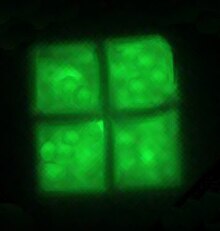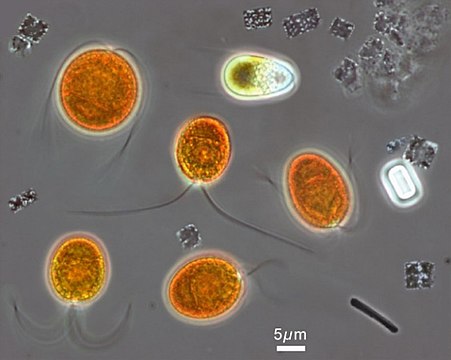Haloquadratum walsbyi
| Haloquadratum walsbyi | |
|---|---|

| |

| |
| Haloquadratum walsbyi | |
| Scientific classification | |
| Domain: | |
| Phylum: | |
| Class: | Halobacteria |
| Order: | |
| Family: | |
| Genus: | |
| Species: | H. walsbyi
|
| Binomial name | |
| Haloquadratum walsbyi Burns et al. 2007
| |
Haloquadratum walsbyi is a species of the genus Haloquadratum, within the
Haloquadratum walsbyi is a
The genus was first observed in 1980 by a British microbiologist, Prof. Anthony E. Walsby, from samples taken from the Sabkha Gavish, a brine lake in southern Sinai, Egypt. This discovery is formally described in 2007 by Burns et al. Attempts to cultivate the archaea were unsuccessful until 2004 and resulted in the identification of Haloarcula quadrata, another species of square archaea of the genus Haloarcula, distinct from H. walsbyi, less abundant and genetically quite different.
Description
Haloquadratum walsbyi cells size at 2 to 5
These
The
Its growth in the laboratory was obtained in a medium with very high chloride concentrations (greater than 2 mol · L−1 of MgCl2 and greater than 3 mol · L −1of NaCl ), making this organism among the most haloresistant known. Its optimum growth temperature is 40 °C (104 °F), making this archaea a Mesophile.
-
Optical phase-contrast microscopy image of a Haloquadratum walsbyi square cell. The numerous light dots are gas vesicles that allow flotation to the surface, most likely to acquire oxygen.[4]Scale bar 1 µm
-
Microscopic image from the hypersalinechlorophyte Dunaliella salinacan be tentatively identified, accompanied by a number of smaller Haloquadratum walsbyi, showing their flat square-shaped cells.
Diversity
A surprisingly high amount of cells in salt brines around the world are Haloquadratum walsbyi, up to 80%. Experiments have been done to examine the genetic diversity in the salt brine environment. Seven different types of H. walsbyi's genomic island have been discovered in natural environments.[6] After examining the metogenomic fosmid library for H. walsbyi, two types of the cell-wall associated islands were identified. The genes in these islands include those responsible for the synthesis of surface layer structures such as glycoproteins and genes responsible for the synthesis of cell envelopes.[3] Homologous recombination is responsible for the maintaining the genes mentioned above and also the diversity of the metagenome in its natural environment. Surface structures on different H. walsbyi cells help to differentiate sources of lineage for the population as a whole. These differing structures also increase the diversity of the cells in their natural environment. These changes in cell structure may be due to the cells' attempts to reduce their susceptibility to attack by viruses.[6] In 2009 an experiment was conducted in Australia to determine the diversity of H. walsbyi in three distinct saltern crystallizer ponds. In all three of the pools that were located in different regions they all shared two 97%-OTU of both Haloquadratum and Halorubrum -like sequences.[7]
Genomics and structure
H. walsbyi is classified as an oligotrophic microorganism, as it grows in nutrient deficient conditions where concentrations of organic substances are minimal. To combat, H. walsbyi maintains a high surface to volume ratio by flattening to maximize nutrient uptake. Because of their square shape, they are more capable of flattening than spherical shaped microorganisms are.[1] H. walsbyi can flatten an extreme amount of about 0.1-0.5μm. The overall size of the cell structure ranges from 1.5 to 11 μm. However, larger cells have been observed. The largest recorded H. walsbyi cell was measured as 40 x 40 μm.[8]
The square shape of H. walsbyi has been the focus of many studies. It is able to maintain this structure due to its adaptive traits.[1] These traits can be found in both H. walsbyi's genome composition as well as its protein sequences. For example, H.walsbyi’s expression of the halomucin protein creates an aqueous protective layering that helps prevent desiccation of the cells.[9] These adaptations allow H. walsbyi to thrive in environments such as saturated brines while also maintaining a defined square structure.[1]
H. walsbyi’s cellular structure consists of highly refractive
A typical Genome of H. walsbyi has a 3,132,494 bp chromosome. The strain HBSQ001, DSM 16790 was analyzed to obtain this data. H. walsbyi is distinguished by the abnormally low Guanine-Cytosine (GC) content compared to other haloarchaea. H. walsbyi has an average of 47.9% GC content compared to the expected 60-70%. Additionally, the proteins encoded are highly conserved specifically in the amino acid sequence. It is understood that H. walsbyi evolved from a typical GC rich, moderately conserving ancestor.[1]
History
The Haloquadratum walsbyi archaea was first discovered in 1980 by a microbiology professor
Upon the observation of the unique shape of H. walsbyi, cultivation has been a goal for scientists studying the species. Hyper-saline media has been found to be a substantial medium to maintain the pure cultures.[13] H. walsbyi remains one of the largest prokaryotes known today and contains roughly 3 million basepairs.[13]
As mentioned earlier, the location site of this distinctive microbe's discovery was in the transcontinental country of Egypt within the Sinai peninsula.[4] However, with this discovery also came an extended period that consisted of intensive trial and error attempts to achieve complete isolation of H. walsbyi. Because of how difficult it was to fully isolate this microorganism, there existed a vast gap in known information on H. walsbyi's physiological processes and genomic composition.[4] However in 2004, two strains of H. walsbyi were successfully isolated and able to be sequenced.[10] The second strain was an Australian isolate, called C23.[10] Five strains were additionally isolated, totaling in seven total isolates of H. walsbyi.[14] In a specific hypersaline environment, Lake Tyrrell, Haloquadratum walsbyi made up nearly 38% of the community of archaea found when the ecosystem was cultured.[15]
Normal microbiota
The Archaeon Haloquadratum walsbyi is abundant in red brines, in salt lakes and solar salter crystallizer ponds,[16] shallow ponds that are connected to each other and increase in salinity.[17] Bacteriorhodopsin, a membrane protein that uses energy from light to drive the hydrogen-ion pump,[18] which are found in Haloquadratum walsbyi absorbs energy from light and are found in communities within these brines.[16] The use of these bacteriorhodopsin shows the photoheterotroph nature of Haloquadratum walsbyi. The salt saturated environments that this archaean inhabits, along with being rich in magnesium chloride, have very low activity within the water which causes desiccation stress. These salt saturated environments can have a salinity of more than ten-times that of average seawater. The magnesium saturation in these ecosystems, what is also referred to as bitterns, are most often found with very little to no life present.[19] This environment is very hostile and H. walsbyi is only able to survive in it due to its unique genomic make up and while other organisms would perish in similar conditions.[1]
References
- ^ PMID 16820047.
- ^ PMID 10425773.
Square bacteria were first observed in 1980 by Walsby in the Gavish Sabkha, a coastal brine pool in the Sinai peninsula, Egypt (Parkes & Walsby, 1981; Walsby, 1980). Walsby recognized these extremely thin, square-shaped structures as prokaryotes...
- ^ a b c Oesterhelt D (2022). "Haloquadratum walsbyi - overview". Max Planck Institute of Biochemistry. Max-Planck-Gesellschaft. Retrieved 2022-11-16.
- ^ PMID 21559517.
- PMID 17267984.
- ^ PMID 26268990.
- PMID 20091074.
- PMID 25870593.
- ^ PMID 21559517.
- ^ PMID 28673248.
- PMID 16820057.
- PMID 19054744.
- ^ PMID 15560825.
- PMID 23637883.
- PMID 22355652.
- ^ S2CID 221797864.
- PMID 10877805.
- PMID 1970644.
- S2CID 24223243.
Further reading
- Lobasso S, Lopalco P, Vitale R, Saponetti MS, Capitanio G, Mangini V, et al. (9 February 2012). "The light-activated proton pump Bop I of the archaeon Haloquadratum walsbyi". Photochemistry and Photobiology. 88 (3): 690–700. S2CID 41934280.
- Cuebas-Irizarry MF, Irizarry-Caro RA, López-Morales C, Badillo-Rivera KM, Rodríguez-Minguela CM, Montalvo-Rodríguez R (November 2017). "Cloning and Molecular Characterization of an Alpha-Glucosidase (MalH) from the Halophilic Archaeon Haloquadratum walsbyi". Life. 7 (4): 46. PMID 29160840.

![Optical phase-contrast microscopy image of a Haloquadratum walsbyi square cell. The numerous light dots are gas vesicles that allow flotation to the surface, most likely to acquire oxygen.[4] Scale bar 1 µm](http://upload.wikimedia.org/wikipedia/commons/thumb/1/14/Optical_phase-contrast_microscopy_image_of_a_Haloquadratum_walsbyi_square_cell_-_PLoS_ONE.png/374px-Optical_phase-contrast_microscopy_image_of_a_Haloquadratum_walsbyi_square_cell_-_PLoS_ONE.png)
